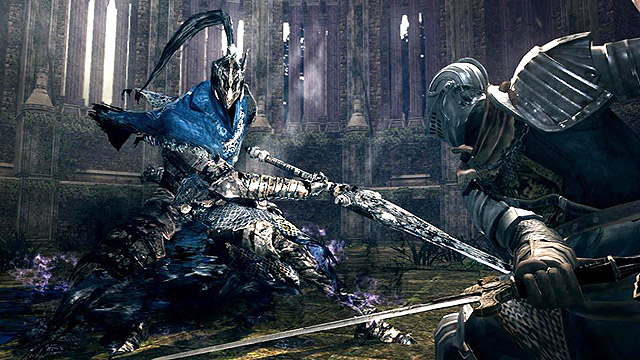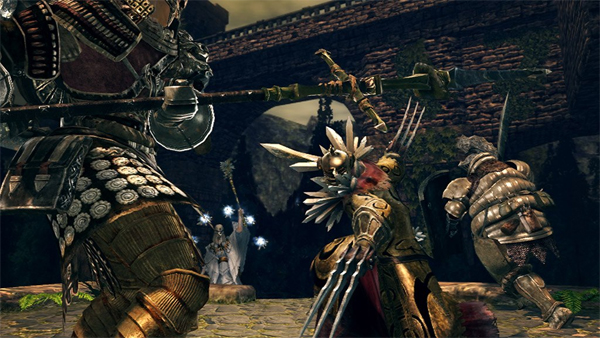 Dark Souls, like Demon’s Souls before it, defies so many gaming sensibilities that either game’s catastrophic failure would not be surprising. However, the truly unique blend of play mechanics and design philosophies have come together two times now in logic-defying synchronicity to create a pair of the best East-West RPGs available to gamers. Dark Souls: Prepare to Die Edition once again embodies that success—its fan-petitioned, straight-ported, expanded-content existence a testament to the game’s more-than-cult acclaim.
Dark Souls, like Demon’s Souls before it, defies so many gaming sensibilities that either game’s catastrophic failure would not be surprising. However, the truly unique blend of play mechanics and design philosophies have come together two times now in logic-defying synchronicity to create a pair of the best East-West RPGs available to gamers. Dark Souls: Prepare to Die Edition once again embodies that success—its fan-petitioned, straight-ported, expanded-content existence a testament to the game’s more-than-cult acclaim.
But it’s not as good this time—still great, just semi-broken… then partially fixed… by a fan.
Dark Souls: Prepare to Die Edition on PC is great for all of the reasons the game was already considered excellent on consoles last year. For more on that, refer to our initial review. Such instruction is valid because the PC version is essentially a straight port of the existing game. In fact, until late in the adventure (and then only if a player is very thorough), it’s impossible to tell that this game includes new content at all. The game’s additional equipment, spells, enemies, NPCs, boss encounters, and revelations regarding its lore are all folded neatly into a completely tangential string of areas hidden in a small, out-of-the-way corner of the game world. And that’s fine, because it suits the minimalist Dark Souls narrative and exploratory design perfectly.

The new content is especially congruent with the mood that From Software’s “Souls” games have worked to invoke over the past three-and-a-half years, its final segment being as foreboding and creepy as any in the series. The bosses are quite difficult to defeat, so prepare to die at the hands of antagonists whose deadliness appropriately eclipses that of most any other soul-bearing roadblock in the main game. From a game design standpoint, this is exactly as add-on DLC should be, and makes sense on the PS3 and 360, as well as in the extended PC version.
The PC version fails in a few ways, technically. The game is nearly unplayable with a mouse and keyboard. The full-control, two-handed control scheme, with its four different attacks, four buttons to cycle weapons, items, and spells, a button to run, dodge, and roll, and one to use items, just doesn’t map in a way that is at all conducive to staying alive. Plugging in a USB controller makes that problem go away, though, and it’s the only reasonable way to viably enjoy the game.
Other interesting limitations in place on the PC version are its resolution and frame rate restrictions, which keep the game running at no higher than 720p resolution with a frame rate of 30fps. This is less desirable than the 1080p, 60fps parameters on other platforms, and is puzzling. Why would From Software limit the game like this? Well, everyone else wondered the same thing, and there is indeed a fan-made patch (Thanks, Durante!) to increase the resolution to 1920×1080, although the frame rate remains at 30fps. And by “remains at” I mean “frequently dips below.” Right. The PC version sees more hiccups than the console versions, and the Games For Windows Live integration makes reliably summoning phantoms a little less reliable than Dark Souls players are used to. This is WONDERFUL when a summoned phantom suddenly drops the connection with my game in the middle of the final boss fight of the Prepare to Die bonus content. *sigh*

Multiplayer, despite its technical drawbacks and some slow matchmaking (“matchmaking” in Dark Souls?), receives a philosophical overhaul, or perhaps just an addendum, with the Prepare to Die Edition. Also hidden toward the end of the game, within the newly unlocked areas of Lordran, is a hall of multiplayer options: three match types for each of two arenas. Unlike the unusually usual invasion-, covenant-, and summons-based multiplayer that Dark Souls has always incorporated, the new “Battle of Stoicism Gazebo” takes a more traditional, albeit more straightforward and bland, approach to competitive play. This area-constrained PvP offers one-on-one dueling, two-on-two team battles, and four-player deathmatches. While I will always contest that Dark Souls‘ original multiplayer is leagues above such types of play due to its range of options and unpredictable dynamics, with the covenant system offering game-within-a-game depth, more options are certainly not a bad thing, and some players may take very kindly to a no-nonsense, no-surprises, level playing field. While it’s not elaborate in any way, and it could be a bit easier to access, the Prepare to Die Edition‘s new multiplayer arena is a fine addition to an already comprehensive multiplayer system.
From Software’s effort on the petition-inspired PC version of Dark Souls, aside from the new Prepare to Die Edition content, was less than what fans had hoped for. A straight port with technical wrinkles could have been replaced by a more refined, optimized version of the game for some of its most loyal fans. Having solidified the game’s excellence a year ago, however, expanding its content can only serve to enhance players’ experiences with the game as a whole, and as add-on DLC for home consoles, it’s hard to press for anything more.

















